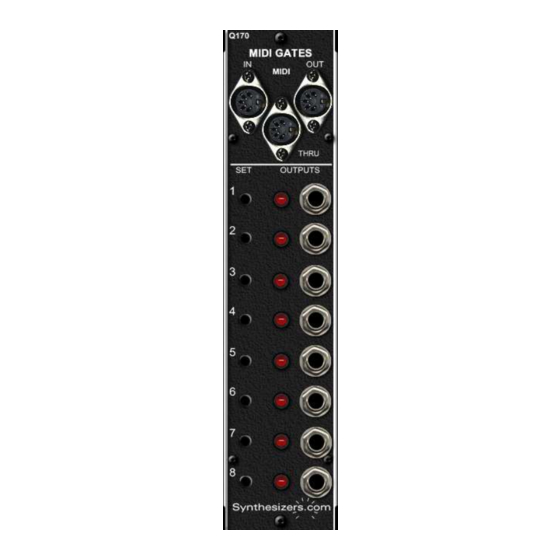
Advertisement
Quick Links
Q170
MIDI Gates
Aug 23, 2018
The Q170 MIDI Gates module produces gate signals from a stream of MIDI
messages, either from a keyboard, a DAW or any MIDI source. Each of the 8
outputs can be programmed for one or more MIDI note messages or Continu-
ous Controller messages.
Gate outputs can be used to select steps on a Q960 sequencer, trigger enve-
lopes, change filter settings and many other things.
A MIDI Thru output allows daisy-chaining of many modules.
The MIDI output is a version of the incoming MIDI signals but with the pro-
grammed notes filtered out. This allows you to set aside certain notes on a key-
board for controlling things via an independent gate signal.
To program an output, simply press the Set button and send MIDI note or CC
messages. MIDI channel numbers are recognized. Notes sent once cause the
output to follow the note on/off messages and operate like a simple keyboard
gate signal. Notes sent twice cause the output to toggle On then Off as note On
messages are received.
A special mode allows gate outputs to be programmed to respond to MIDI real-
time messages, sometimes called sync - start, stop, continue, clock. The clock
output can be programmed with a division
of /1, /2, /3, /4, /6, /8, /12, /16, /24, /32, /48, /96, /192.
Programming is preserved through power cycling.
Q170 MIDI Gates Specifications
Panel Size: Single Width 2.125"w x 8.75" (Moog Unit Format).
Gate Outputs: 5V positive.
Trigger Width: 5ms.
Power Requirement: +15V@30ma, -15V@30ma, +5V@50ma. Synthesizers.com standard.
MIDI Messages Recognized: Notes, Continuous Controllers, Clock, Start, Stop, Continue.
Clock Division Options: /1,/2,/3,/4,/6,/8,/12,/16,/24,/32, /48, /96, /192.
Total Messages Programmable: 100 per gate, 800 total.
Advertisement

Summary of Contents for Synthesizers.com Q170 MIDI Gates
- Page 1 MIDI Gates Aug 23, 2018 The Q170 MIDI Gates module produces gate signals from a stream of MIDI messages, either from a keyboard, a DAW or any MIDI source. Each of the 8 outputs can be programmed for one or more MIDI note messages or Continu- ous Controller messages.
-
Page 2: Panel Overview
Panel Overview The Q170 MIDI Gates module creates gate signals for specific keys of a MIDI keyboard or MIDI signal source. Each of the 8 outputs can be programmed for any key or CC. Gates can be used to select steps on a Q960 sequencer, trigger envelopes, change filter settings and many other things. - Page 3 MIDI Gates MIDI Message Interpretation In these examples, a keyboard is assumed to be the source of MIDI messages to the Q170 MIDI Gates module. The source could be any other controller or a computer (DAW). Every message, without excep- tion, is sent to the MIDI Thru output.
- Page 4 Q170 MIDI Gates MIDI Message Interpretation Other MIDI Messages The following MIDI messages are not programmable and are passed through to the Thru and Output con- nectors - aftertouch, program change, channel pressure, pitch wheel, system common messages. There is no compelling reason to add the complexity and processing time required for programming these mes- sages since note and CC messages provide an abundant source.
-
Page 5: Basic Usage
MIDI Gates Basic Usage Here's a basic patch with a keyboard producing MIDI messages. The Q170 MIDI Gates module creates gates according to its programming and the MIDI signal is sent on to the Q174 MIDI interface module to produce pitch and gate for a synth voice. The gates from the Q170 can be used to start sequencers, trig-... - Page 6 Q170 MIDI Gates Sequencer Step Selection Patch This patch lets the user select specific steps on a Q960 sequencer. Program the Q170 MIDI Gate mod- ule to respond to an array of keys, then set the sequencer knobs to voltages that correspond to any note you wish.
- Page 7 Q170 MIDI Gates Transposing This example uses a gate output to transpose specific notes. The 5V gate signal is patched into the Q106 VCO's variable 1V/Octave CV jack. Adjust the knob for the transposition you want. With this patch, certain keys on a keyboard could be transposed, possibly an octave higher or some other musically use- ful amount.
- Page 8 Q170 MIDI Gates Sequencer Clock Control In this patch, gate outputs from the Q170 are used to clock a Q960 sequencer and to restart it for syncing to other gear or a DAW. Patch MIDI Thru on to the Q174 MIDI Interface for normal pitch/gate creation. The unused gate outputs can be used for other things if you want.
-
Page 9: Troubleshooting
Q170 MIDI Gates MIDI Time Delays The time between MIDI input data and Thru output data is ~0s since it's a hardware connection. The time between the start of MIDI input data and the start of filtered data output is 0.65ms. That in- creases to 0.75ms if there are 10 notes programmed for each of the 8 channels.







Need help?
Do you have a question about the Q170 MIDI Gates and is the answer not in the manual?
Questions and answers